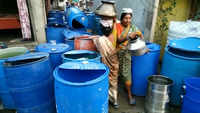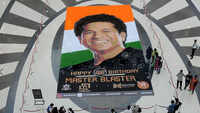
Keonjhar: Elections have come to an end in Keonjhar but that has not stopped the banners and billboards of different political parties from attracting attention. Though leaders of different parties promised sops for the poor, it is their discarded publicity material that is actually providing some help to those in need in this mineral-rich belt of the state.
The poor of the area — who voted amid violence in the third phase on April 23 — have fashioned bedsheets out of poll banners. Some are using billboards as carrom boards, while others are using giant posters to paper over damages in their roofs. Many are using them to build tents to rest for a while in the searing summer heat.
Desu Juanga, a youth, said, “During elections, the leaders came and begged for votes. They gave several assurance and promises. While nobody is sure of whether they will keep the promises, at least these (the election material) have become very useful to us.”
“We use a banner to cover our thatched roof. Some people I know are using a banner as a bathroom door or to make partition between rooms,” the youth added.
Dasaru Munda, a tribal resident of Banspal, added that the flex banners were water-proof and especially useful.
While those in need have found the materials to be of some use, environmentalists are less than amused at the banners and boards being strewn about. They said political parties should take steps to dispose of these to avoid pollution. “Given the volume of publicity materials dumped, they pose a major risk to the environment. Use of toxic materials and colour in flex banners is bad for the environment and our health,” said Harekrushna Mohapatra, an environmentalist.
Officials of the Odisha State Pollution Control Board (OSPCB) said the flex and banners would not even decompose easily. “The government has prohibited the use of polythene material with thickness of less than 50 microns. These are more than that. Though action can’t be taken against parties for using such materials, they must do something to avoid pollution,” said Puskar Behera, regional officer of OSPCB in Keonjhar.
The poor of the area — who voted amid violence in the third phase on April 23 — have fashioned bedsheets out of poll banners. Some are using billboards as carrom boards, while others are using giant posters to paper over damages in their roofs. Many are using them to build tents to rest for a while in the searing summer heat.
In Kodipasa village under Banspal block, children were seen using poll banners as mats to play cards on. In the same village, another group of children used a billboard — turned upside-down for a smoother surface — to play carrom.
Desu Juanga, a youth, said, “During elections, the leaders came and begged for votes. They gave several assurance and promises. While nobody is sure of whether they will keep the promises, at least these (the election material) have become very useful to us.”
“We use a banner to cover our thatched roof. Some people I know are using a banner as a bathroom door or to make partition between rooms,” the youth added.
Dasaru Munda, a tribal resident of Banspal, added that the flex banners were water-proof and especially useful.
While those in need have found the materials to be of some use, environmentalists are less than amused at the banners and boards being strewn about. They said political parties should take steps to dispose of these to avoid pollution. “Given the volume of publicity materials dumped, they pose a major risk to the environment. Use of toxic materials and colour in flex banners is bad for the environment and our health,” said Harekrushna Mohapatra, an environmentalist.
Officials of the Odisha State Pollution Control Board (OSPCB) said the flex and banners would not even decompose easily. “The government has prohibited the use of polythene material with thickness of less than 50 microns. These are more than that. Though action can’t be taken against parties for using such materials, they must do something to avoid pollution,” said Puskar Behera, regional officer of OSPCB in Keonjhar.
#ElectionsWithTimes
more from times of india cities
Elections 2019

Trending Topics
LATEST VIDEOS
City
 Nagpur: Water crisis for Wadi residents, water tanker sent to locality after 15 days
Nagpur: Water crisis for Wadi residents, water tanker sent to locality after 15 days  Navi Mumbai: Unique artwork on master blaster Sachin Tendulkar’s 46th birthday at Seawoods Grand Central Mall
Navi Mumbai: Unique artwork on master blaster Sachin Tendulkar’s 46th birthday at Seawoods Grand Central Mall  Delhi: Gautam Gambhir addresses party workers during introductory meet
Delhi: Gautam Gambhir addresses party workers during introductory meet  Lok Sabha elections 2019: BJP fields singer Hans Raj Hans from North-West Delhi
Lok Sabha elections 2019: BJP fields singer Hans Raj Hans from North-West Delhi
More from TOI
Navbharat Times
Featured Today in Travel
Quick Links
Lok Sabha Election Schedule 2019Lok Sabha Election NewsDelhi Capitals teamMI team 2019Rajasthan Royals 2019RCB team 2019Maharashtra Lok Sabha ConstituenciesBJP Candidate ListBJP List 2019 TamilnaduShiv Sena List 2019AP BJP List 2019Mamata BanerjeeBJP List 2019 MaharashtraPriyanka GandhiBJP List 2019 KarnatakaAMMK Candidate List 2019BJP List 2019 WBLok Sabha Elections in Tamil NaduBSP List 2019 UPNews in TamilLok Sabha Poll 2019Satta Matka 2018PM ModiMahagathbandhanNagpur BJP Candidate ListChandrababu NaiduTamil Nadu ElectionsUrmila MatondkarNews in TeluguMadras High CourtTejashwi YadavArvind KejriwalTejasvi SuryaPawan KalyanArvind KejriwalYogi AdityanathJaya PradaSatta King 2019Srinagar encounter
Get the app




